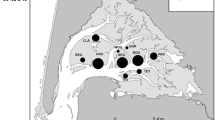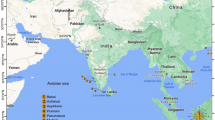Abstract
A sudden outbreak of the parasitic sea spider Nymphonella tapetis accompanied by mass mortality of the Manila (asari) clam Ruditapes philippinarum was observed in Japan in 2007. It was unknown why dead and dying clams were found on the sand surface. In our laboratory experiment, in which sea spiders were artificially parasitised to host clams, unburied clams were significantly increased, suggesting that sea spider parasitism can change the burial mode of clams. We compared parasite loads, somatic condition and reburial activity of Manila clams among three burial groups (fully buried, partly buried and unburied) collected from the field. Unburied and partly buried clams had 30% lower soft body weight and 60% lower adductor strength as compared to the fully buried clams. Parasite prevalence and the mean infection intensity were greater in unburied and partly buried clams than in fully buried clams. Reburial depth was smaller in unburied and partly buried clams than in fully buried clams under laboratory conditions. Approximately 30% of the unburied and partly buried clams died during 30 days, whereas fully buried clams suffered no mortality. These results indicate that sea spider parasitism can reduce the burial depth and somatic condition of host clams, and eventually cause clam mortality on the sand.





Similar content being viewed by others
References
Arnaud, F. & R. N. Bamber, 1988. The biology of Pycnogonida. Advances in Marine Biology 24: 1–96.
Binias, C., P. Gonzalez, M. Provost, C. Lambert & X. de Montaudouin, 2014. Brown muscle disease: impact on Manila clam Venerupis (=Ruditapes) philippinarum biology. Fish & Shellfish Immunology 36: 510–518.
Brusca, R. C. & G. J. Brusca, 2003. Invertebrates, 2nd edn. Sinauer, Sunderland: 936 p.
Dang, C. & X. de Montaudouin, 2009. Brown muscle disease and Manila clam Ruditapes philippinarum dynamics in Arcachon Bay, France. Journal of Shellfish Research 28: 355–362.
de Goeij, P., P. C. Luttikhuizen, J. van der Meer & T. Piersma, 2001. Facilitation on an intertidal mudflat: the effect of siphon nipping by flatfish on burying depth of the bivalve Macoma balthica. Oecologia 126: 500–506.
de Vlas, J., 1979. Annual food intake by plaice and flounder in a tidal flat area in the Dutch Wadden Sea, with special reference to consumption of regenerating parts of macrobenthic prey. Netherlands Journal of Sea Research 13: 117–153.
Desclaux, C., X. de Montaudouin & G. Bachelet, 2002. Cockle emergence at the sediment surface: favourization’ mechanism by digenean parasites? Diseases of Aquatic Organisms 52: 137–149.
Edelaar, P., J. Drent & P. de Goeij, 2003. A double test of the parasite manipulation hypothesis in a burrowing bivalve. Oecologia 134: 66–71.
Fermer, J., S. C. Culloty, T. C. Kelly & R. M. O’Riordan, 2011. Manipulation of Cerastoderma edule burrowing ability by Meiogymnophallus minutus metacercariae? Journal of the Marine Biological Association of the United Kingdom 91: 907–911.
Fox, J. & S. Weisberg, 2011. An {R} Companion to Applied Regression, 2nd edn. Sage, Thousand Oaks. http://socserv.socsci.mcmaster.ca/jfox/Books/Companion.
Kikuchi, T., 1976. Rediscovery of the bivalve-infesting Pycnogonida, Nymphonella tapetis Ohshima 1927, in Amakusa. Publications from the Amakusa Marine Biological Laboratory, Kyushu University 4: 51–56.
Kondo, Y., 1987. Burrowing depth of infaunal bivalves – observation of living species and its relation to shell morphology. Transactions and Proceedings of the Palaeontological Society of Japan 148: 306–323.
Lafferty, K. D. & A. K. Morris, 1996. Altered behavior of parasitized killifish increases susceptibility to predation by bird final hosts. Ecology 77: 1390–1397.
Meyer, J. J. & J. E. Byers, 2005. As good as dead? Sublethal predation facilitates lethal predation on an intertidal clam. Ecology Letters 8: 160–166.
Miyazaki, K., Y. Kobayashi, M. Toba & H. Tsuchiya, 2010. Biology of Nymphonella tapetis Ohshima, 1927, a harmful pycnogonid endoparasitic on the commercial bivalve, Ruditapes philippinarum. Taxa, Proceedings of the Japanese Society of Systematic Zoology 28: 45–54 (in Japanese with English abstract).
Mouritsen, K. N., 1997. Crawling behaviour in the bivalve Macoma balthica: the parasite-manipulation hypothesis revisited. Oikos 79: 513–520.
Mouritsen, K. N., 2002. The parasite-induced surfacing behaviour in the cockle Austrovenus stutchburyi: a test of an alternative hypothesis and identification of potential mechanisms. Parasitology 124: 521–528.
Mouritsen, K. N. & R. Poulin, 2003. Parasite-induced trophic facilitation exploited by a non-host predator: a manipulator’s nightmare. International Journal for Parasitology 33: 1043–1050.
Mouritsen, K. N. & R. Poulin, 2005. Parasites boost biodiversity and change animal community structure by trait-mediated indirect effects. Oikos 108: 344–350.
O’Dwyer, K., T. Kamiya & R. Poulin, 2014. Altered microhabitat use and movement of littorinid gastropods: the effects of parasites. Marine Biology 161: 437–445.
Ogawa, K. & K. Matsuzaki, 1985. Discovery of bivalve-infesting Pycnogonida, Nymphonella tapetis, in a new host, Hiatella orientalis. Zoological Science 2: 583–589.
Ohshima, H., 1927. Nymphonella tapetis n. g., n. sp., a pycnogon parasite in a bivalve. Annotationes Zoologicae Japonenses 11: 257–263.
Ohshima, H., 1933. The adult of the bivalve-infesting pycnogonid, Nymphonella tapetis Ohshima. Annotationes Zoologicae Japonenses 14: 53–60.
Perrot-Minnot, M. J., N. Kaldonski & N. Cézilly, 2007. Increased susceptibility to predation and altered anti-predator behaviour in an acanthocephalan-infected amphipod. International Journal for Parasitology 37: 645–651.
Poulin, R., 2000. Manipulation of host behaviour by parasites: a weakening paradigm? Proceedings of the Royal Society B 267: 787–792.
Poulin, R., 2010. Parasite manipulation of host behavior: an update and frequently asked questions. Advances in the Study of Behavior 41: 151–186.
Poulin, R., 2013. Parasite manipulation of host personality and behavioural syndromes. Journal of Experimental Biology 216: 18–26.
Sassa, S., Y. Watabe, S. Yang & T. Kuwae, 2011. Burrowing criteria and burrowing mode adjustment in bivalves to varying geoenvironmental conditions in intertidal flats and beaches. PLoS One 6(9): e25041.
Shirakashi, S., K. Teruya & K. Ogawa, 2008. Altered behaviour and reduced survival of juvenile olive flounder, Paralichthys olivaceus, infected by an invasive monogenean, Neoheterobothrium hirame. International Journal for Parasitology 38: 1513–1522.
Thieltges, D. W., 2006. Parasite induced summer mortality in the cockle Cerastoderma edule by the trematode Gymnophallus choledochus. Hydrobiologia 559: 455–461.
Thompson, R. M., K. N. Mouritsen & R. Poulin, 2005. Importance of parasites and their life cycle characteristics in determining the structure of a large marine food web. Journal of Animal Ecology 74: 77–85.
Tomiyama, T., M. Omori & T. Minami, 2007. Feeding and growth of juvenile stone flounder in estuaries: generality and the importance of sublethal tissue cropping of benthic invertebrates. Marine Biology 151: 365–376.
Watanabe, S. & S. Katayama, 2010. Relationships among shell shape, shell growth rate, and nutritional condition in the Manila clam (Ruditapes philippinarum) in Japan. Journal of Shellfish Research 29: 353–359.
Yoshinaga, T., Y. Kobayashi, M. Toba & Y. Miyama, 2011. Development of a sensitive method for the detection of young larvae of the parasitic pycnogonid Nymphonella tapetis in Manila clam Ruditapes philippinarum. Fish Pathology 46: 38–41.
Zar, J. H., 1999. Biostatistical Analysis, 4th ed. Prentice Hall, New Jersey.
Zwarts, L. & J. Wanink, 1991. The macrobenthos fraction accessible to waders may represent marginal prey. Oecologia 87: 581–587.
Acknowledgments
We thank fishermen who supported our field sampling in Matsukawaura Lagoon. This work was partly supported by the Research Institute of Marine Invertebrate Foundation to K. Yamada, by the Agriculture, Forestry and Fisheries Research Council, Japan (No. 22028), and by JSPS KAKENHI Grant Number 26292105.
Author information
Authors and Affiliations
Corresponding author
Additional information
Handling editor: Vasilis Valavanis
Rights and permissions
About this article
Cite this article
Tomiyama, T., Yamada, K., Wakui, K. et al. Impact of sea spider parasitism on host clams: relationships between burial patterns and parasite loads, somatic condition and survival of host. Hydrobiologia 770, 15–26 (2016). https://doi.org/10.1007/s10750-015-2564-y
Received:
Revised:
Accepted:
Published:
Issue Date:
DOI: https://doi.org/10.1007/s10750-015-2564-y




